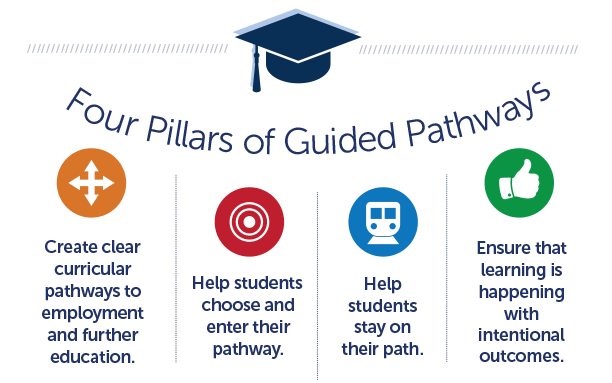Instructional Outcomes
A learning outcome defines what a student should know, think, or be able to do upon completing a course of study or a set of activities. Because their purpose is to allow comparison of student performance to the College’s expectations in terms of institutional-level, program-level, and course-level outcomes (i.e., ILOs, PLOs, and CLOs), outcomes are results-oriented and facilitate the assessment process. Assessment strategies should be nurtured, evaluated, and refined continually in order to further the success of students, so the regular assessment of outcomes is key to this work.
In Ten Frequently Asked Questions about SLOs [i.e., CLOs] (2020), Apigo, Baker, and Janio identify three important purposes to engaging in the outcome assessment process: (1) continuous improvement of teaching and learning; (2) gathering evidence of learning in support of institutional improvement; and (3) demonstrating to regional accrediting commissions, such as the Accreditation Commission of Community and Junior Colleges (ACCJC), that the institution is engaged in a continuous cycle of ensuring quality in its teaching and learning efforts.
Indeed, as stated in Nine Principles of Good Practice of Assessing Student Learning,
Assessment is not an end of itself but a vehicle for educational improvement. Its effective practice, then, begins with and enacts a vision of the kinds of learning we most value for students and strive to help them achieve. Educational values should drive not only what we chose to assess but also how we do so. Where questions about educational mission and values are skipped over, assessment threatens to be an exercise in measuring what’s easy, rather than a process of improving what we really care about.
(Banta, Lund, Black, and Oblander, 1996)
Institutional-level outcomes (ILOs) are used to determine if students’ mastery is in line with Rio Hondo College’s overall objectives and learning goals. Effective January 2018, the College has 17 ILOs in five areas:
Students who complete programs at the College will be able to:
Program-level outcomes (PLOs) are used to determine if students’ mastery is in line with the learning objectives and goals of the specific degree or certificate program.
PLOs can be found in the course catalog.
Course-level outcomes (CLOs) are used to determine if the student has mastered the course material. CLOs are sometimes referred to as student learning outcomes (SLOs), but for the purposes of consistency and simplicity, the Outcomes Committee recommends using the abbreviation CLOs.
CLOs are included in the College’s online schedule of classes. CLOs for a given course can be displayed by clicking on the course’s course reference number (CRN), and then on the “Learning Outcomes and Important Section Information” link in the resultant pop-up window.
Yes. Faculty members’ ability to demonstrate that outcomes are identified and regularly assessed—and the results used to improve student learning—are key processes that will determine whether Rio Hondo College is an accredited institution. The importance of outcomes assessment is also underscored in the College’s Faculty Handbook:
Rio Hondo College is accredited by the Western Association of Schools and Colleges (WASC) through the Accrediting Commission of Community and Junior Colleges (ACCJC). As part of the college accreditation process, all courses and programs must have [course-level outcomes (CLOs)] identified and regularly assessed. The [CLOs] assessment process helps faculty members evaluate the knowledge and skills acquired by students through their participation in a course or academic program.
(Rio Hondo College Faculty Handbook, 2019–2020)
How are Course-Level and Program-Level Outcomes Related to Guided Pathways?
Outcomes are linked to the fourth pillar of Guided Pathways (“Ensure learning is happening ...”) as it connects coursework “with intentional outcomes.” Consideration of intentionality means thinking about intentional actions (i.e., the things people do) rather than any unintended outcomes that might occur as a result of a given practice or method. Again:

Assessment fosters greater improvement when representatives from across the educational community are involved. Student learning is a campus-wide responsibility and assessment is a way of enacting that responsibility. Thus, while assessment efforts may start small, the aim over time is to involve people from across the educational community. Faculty play an especially important role, but assessment’s questions can’t be fully addressed without participation by student affairs educators, librarians, administrators, and students.
(Banta, Lund, Black, and Oblander, 1996)
Successful assessment is directed toward making improvements in students’ education. These improvements may occur in teaching, student learning, academic and support programs, or institutional effectiveness. Assessment information must be applied systematically toward improvements if assessment is to have a lasting impact on the institution.
Successful assessment techniques are adaptable, creative, reliable, accurate, and repeatable. Through the use of multiple methods, triangulation, and the measurement of performance and knowledge over time, effective assessment techniques can begin to capture and reflect the complex nature of learning.
Effective assessment practices should be utilized to inform the College’s many constituencies about the ways campus services and programs affect students and the community positively. In this way, assessment is an important component in demonstrating institutional accountability.